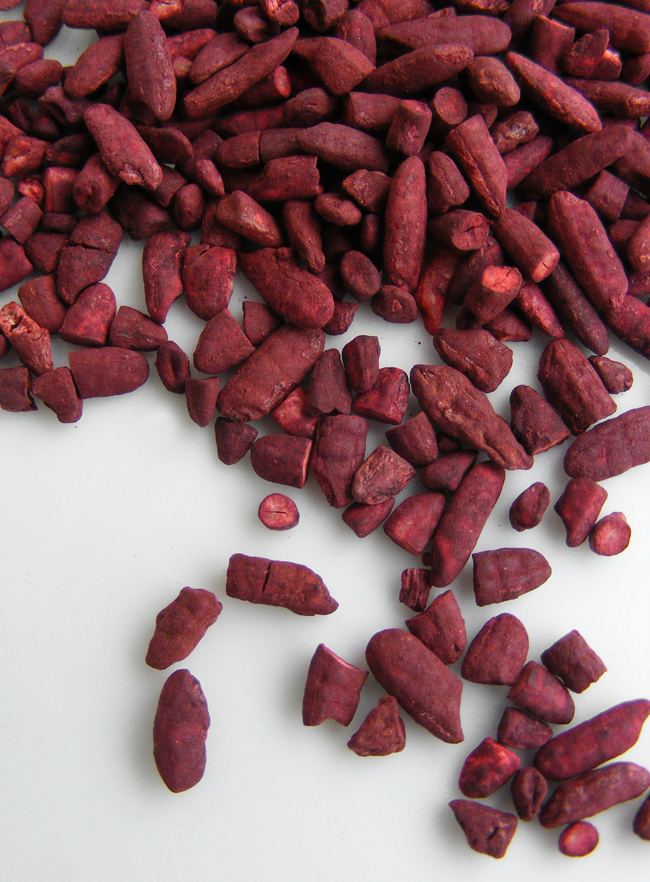The maintenance of skin strength and elasticity depends heavily on the extracellular matrix (ECM), which is composed primarily of elastin, hyaluronic acid, and collagen. Skin aging, driven by both extrinsic and intrinsic factors, is characterized by a reduction in ECM production, which subsequently leads to the formation of wrinkles and sagging. Furthermore, inflammation and free radicals accelerate the aging process by activating collagenases and elastases, enzymes that actively degrade existing elastin and collagen fibers.
In response to these challenges, there has been a growing demand for natural bioactive ingredients derived from sources such as fungi and microbes to counteract aging and promote skin health. Fungal pigments (biocolors) are gaining popularity in this field because they are natural, generally non-toxic, exhibit rapid growth, and can be produced independently of weather conditions, making them suitable for large-scale production. Monascus purpureus, a red mold species, produces pigments known to possess various health benefits, including anti-inflammatory, antioxidant, and anti-aging properties, with previous reports highlighting their potential in photoprotective applications and the inhibition of skin aging-related enzymes like elastase. Thus, the study investigated the antioxidant and biological activities of M. purpureus biocolor extracts to determine their potential as anti-aging agents in cosmetic and cosmeceutical applications.
Methods
Monascus purpureus TISTR 3615 was cultivated in potato dextrose broth (PDB) both with and without 1% Tubtim chumphae broken rice (MPtR) in a 5 L bioreactor for seven days to enhance pigment production. The resulting extracts were then analyzed using liquid chromatography-mass spectrometry (LC–MS) to identify and quantify key pigment compounds. The biological activities of the extracts were extensively evaluated via multiple in vitro assays, including antioxidant capacity (DPPH•, ABTS•+, FRAP), enzyme inhibition (anti-collagenase, anti-elastase), and cytotoxicity (WST-1 assay on Human Dermal Fibroblasts, HDFn). Additionally, the study assessed the extracts’ ability to promote cellular production of collagen type I and elastin in HDFn cells and investigated their efficacy in wound healing using a scratch assay.
Key Findings
The MPTR extract demonstrated significant anti-aging potential across multiple biological activities:
• Enhanced Pigment Production and Yield: MPTR extract, derived from fermentation with broken rice, exhibited superior production intensity across yellow, orange, and red pigments compared to the conventional extract (MP). The yield of MPTR extract was 22.81 ± 1.19%, which was higher than that of MP extract (19.31 ± 1.02%).
• Unique Composition: LC–MS analysis showed that MPTR contained six key pigment compounds, including the red pigments rubropunctamine, monascorubramine, monascopyridine B, and monasfluor A, and the yellow pigments monascin and ankaflavin; notably, MPTR uniquely contained monasfluor A compared to the MP extract.
• Potent Antioxidant Activity: MPTR extract exhibited significantly higher antioxidant activity than MP extract in all assays tested, including DPPH• (IC50 0.88 mg/mL vs 1.25 mg/mL) and ABTS•+ (IC50 0.79 mg/mL vs 1.01 mg/mL).
• Enzyme Inhibition: MPTR extract showed stronger inhibitory effects against key skin aging enzymes, collagenase (IC50 1.21 mg/mL) and elastase (IC50 1.01 mg/mL), compared to MP extract (IC50 values of 1.79 mg/mL and 1.89 mg/mL, respectively).
• Safety and Regenerative Effects on HDFn: MPTR extract was non-cytotoxic to human dermal fibroblasts (HDFn) at concentrations up to 0.5 mg/mL.
• Collagen and Elastin Promotion: Treatment with MPTR extract significantly induced cellular production of both collagen type I (up to 7.23 µg/mL) and elastin (up to 55.39 µg/mL) in HDFn.
• Wound Healing: MPTR extract promoted wound healing in vitro, significantly reducing the wound area in HDFn by up to 90% within 48 hours at the highest tested concentration (0.5 mg/mL).
The novelty of this research lies in its finding that a Monascus extract is able to simultaneously promote the production of both collagen type I and elastin in human dermal fibroblasts, a synergistic effect previously unreported for Monascus species. While extracts from other molds have been shown to inhibit aging enzymes and stimulate collagen synthesis, this dual regenerative capacity in Monascus extracts represents a significant advancement. Furthermore, the exclusive presence of the red pigment monasfluor A in the MPTR extract, induced by the broken rice supplementation, is particularly noteworthy and may contribute to the enhanced bioactivities observed.
For future implications, the findings underscore the promising applications of MPTR extract in the development of natural-based therapeutic and cosmetic products, particularly those aimed at skin regeneration and anti-aging treatments. The mechanisms by which MPTR induces the production of both type I collagen and elastin warrant further, detailed investigation.
Link to the study: https://tinyurl.com/432h582v

